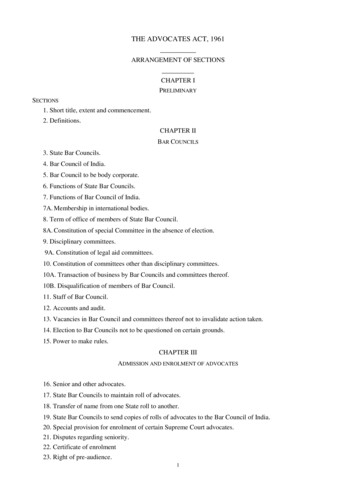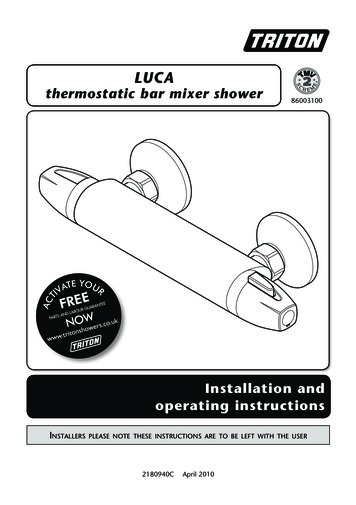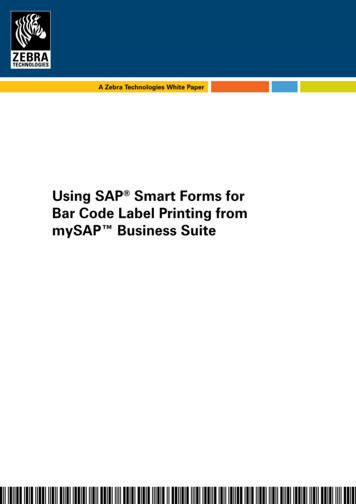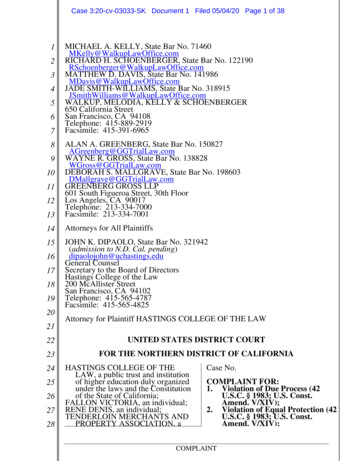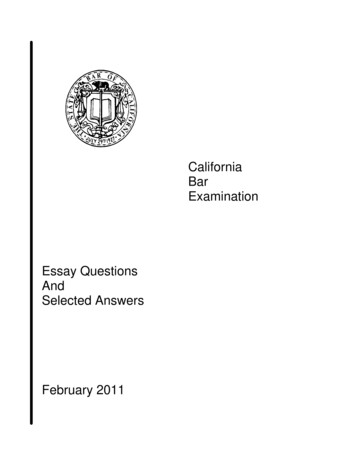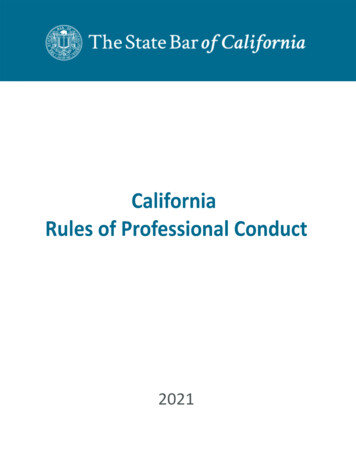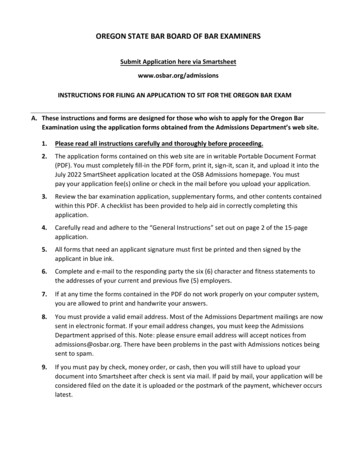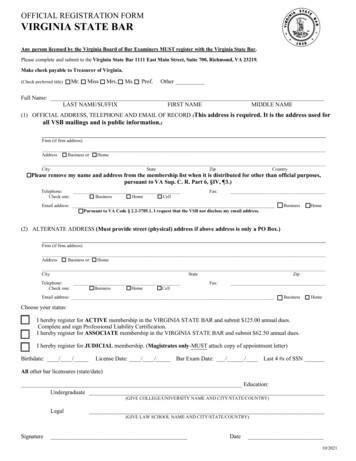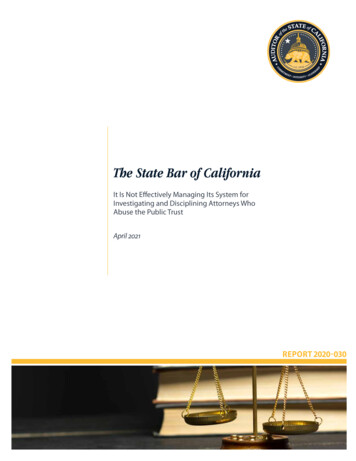
Transcription
The State Bar of CaliforniaIt Is Not Effectively Managing Its System forInvestigating and Disciplining Attorneys WhoAbuse the Public TrustApril 2021REPORT 2020‑030
CALIFORNIA STATE AUDITOR621 Capitol Mall, Suite 1200 Sacramento CA 95814916.445.0255 TTY 916.445.0033For complaints of state employee misconduct,contact us through the Whistleblower Hotline:1.800.952.5665Don’t want to miss any of our reports? Subscribe to our email list atauditor.ca.govFor questions regarding the contents of this report, please contact Margarita Fernández, Chief of Public Affairs, at 916.445.0255This report is also available online at www.auditor.ca.gov Alternative format reports available upon request Permission is granted to reproduce reports
Elaine M. Howle State AuditorApril 29, 20212020-030The Governor of CaliforniaPresident pro Tempore of the SenateSpeaker of the AssemblyState CapitolSacramento, California 95814Dear Governor and Legislative Leaders:As Business and Professions Code section 6145 (b) requires, my office presents this report of ouraudit of the State Bar of California (State Bar) and our findings that the State Bar’s reorganizationof its discipline system has neither satisfied its statutory requirements nor improved the efficiencyor effectiveness of the discipline system.In 2016 the State Bar reorganized the staffing for its discipline system in response to a review of thesystem prompted by a requirement established in state law. However, from 2015 through 2020, caseprocessing times for the investigative phase of attorney discipline cases increased by 56 percent,and the backlog of cases increased by 87 percent. These delays allow attorneys under investigationto continue practicing law while their cases are pending, increasing the potential for harm to thepublic. Moreover, the State Bar has not effectively monitored the impact of its reorganizationbecause it does not adequately measure the performance of its discipline system staff.State law also requires the State Bar to publish an annual discipline report describing theperformance and condition of the discipline system, including the backlog of cases. However, theState Bar’s 2019 discipline report did not present complete or consistent information, limitingstakeholders’ ability to evaluate the discipline system’s performance. For example, it omitted sometypes of cases from its reported caseload, and it did not include information for other topics forpast years—as state law requires. These omissions indicate that the current oversight providedby the Board of Trustees of the State Bar and the board committee responsible for overseeing thediscipline report is inadequate.Finally, the State Bar did not follow its policies when it contracted for examination software.It entered into a contract to obtain state bar exam software—and later entered into a contractamendment for additional security features necessary to remotely administer the state barexamination in response to the COVID-19 pandemic—collectively worth almost 4 million.However, the State Bar should have assessed and documented that the selected vendor providedthe best value, which it did not do.Respectfully submitted,ELAINE M. HOWLE, CPACalifornia State Auditor621 Capitol Mall, Suite 1200 Sacramento, CA 95814 916.445.0255 916.327.0019 fax w w w. a u d i t o r. c a . g o v
ivReport 2020-030 C ALIFO R N IA S TAT E AUD I TO RApril 2021Selected Abbreviations Used in This ReportJusticeCalifornia Department of Justicetrial counsel’s officeThe Office of Chief Trial Counsel of the State BarState BarThe State Bar of CaliforniaSupreme CourtCalifornia Supreme Court
C ALIFO R N IA S TAT E AUD I TO R Report 2020-030April 2021CONTENTSSummary1Introduction5The State Bar’s Changes to Its Discipline System Have SignificantlyReduced That System’s Efficiency11The State Bar’s Discipline Report Does Not Provide All RequiredInformation, and Its Publishing Date Reduces Its Value to Stakeholders21The State Bar Appropriately Administered the Bar Exam During theCOVID-19 Pandemic, but Its Procurement of Exam Software Did NotComply With Its Policy27Other Areas We Reviewed31AppendixScope and Methodology and Assessment of Data Reliability33Response to the AuditThe State Bar of California35California State Auditor’s Comments on the Response Fromthe State Bar of California45v
viReport 2020-030 C ALIFO R N IA S TAT E AUD I TO RApril 2021Blank page inserted for reproduction purposes only.
C ALIFO R N IA S TAT E AUD I TO R Report 2020-030April 2021SUMMARYAttorneys hold significant responsibility as representatives and advisors of their clients.Their responsibilities include providing clients with an informed understanding of theirlegal rights and aiding them during certain times of crisis. To ensure that attorneysuphold the trust placed in them, every person admitted and licensed to practice law inCalifornia—with limited exceptions—must be a licensee of the State Bar of California(State Bar). The State Bar’s core mission is to protect the public from attorneys whowould abuse the public’s trust. It does so by licensing attorneys, enforcing rulesof professional conduct for attorneys, disciplining attorneys when necessary, andsupporting greater access to the legal system. The State Bar is also required to issuean Annual Discipline Report (discipline report) that describes the performance andcondition of its attorney discipline system. This audit report concludes the following:The State Bar’s Changes to Its Discipline System Have SignificantlyReduced That System’s EfficiencyPage 11Beginning in 2016, the State Bar reorganized the staffing of itsdiscipline system, converting its discipline staff from specialists togeneralists and promoting its most senior attorneys to full‑timesupervisors. These actions neither addressed the recommendationsand statutory requirements that originally prompted the State Bar’sreview of its discipline system nor produced measurably positiveresults. In fact, from 2015 through 2020, case processing timesfor attorney discipline cases increased 56 percent and the backlogof unresolved cases increased 87 percent. The State Bar has noteffectively monitored the impact of its reorganization because it doesnot effectively measure the performance of its discipline system staff.The State Bar’s Discipline Report Does Not Provide AllRequired Information, and Its Publishing Date Reduces ItsValue to StakeholdersState law requires that each year, the State Bar publish a disciplinereport describing the performance and condition of its disciplinesystem, including the number of cases in its backlog. However, theState Bar did not present complete or consistent information in its2019 discipline report, thus limiting stakeholders’ ability to evaluateits administration of the discipline system. For example, the State Baromitted some types of cases from its caseload metrics and did notprovide certain past data necessary for year‑to‑year comparisons,as state law requires. The amount of information missing from thediscipline report suggests that the current oversight provided by thePage 211
2Report 2020-030 C ALIFO R N IA S TAT E AUD I TO RApril 2021Board of Trustees of the State Bar (board) and the board committeeresponsible for overseeing the discipline report is inadequate forproducing an accurate description of the State Bar’s discipline system.Further, the April 30 statutory deadline for submitting the disciplinereport limits the amount of time the Legislature has to review itbefore deliberating on legislation that sets the annual license fees theState Bar may charge attorneys (fee bill).Page 27The State Bar Appropriately Administered the Bar Exam Duringthe COVID‑19 Pandemic, but Its Procurement of Exam SoftwareDid Not Comply With Its PolicyIn response to the COVID‑19 pandemic, the State Bar effectivelyimplemented orders from the California Supreme Court to create atemporary supervised licensure program and to remotely administerthe state bar examination (bar exam) for a limited time. In doing so,the State Bar contracted with a software vendor to obtain securityfeatures to help ensure the bar exam’s integrity. Although the StateBar’s procurement policy provides its contract managers withdiscretion when selecting vendors for the bar exam, it does requirethem to assess and document that the selected vendor providesthe best value. The State Bar’s contract manager ignored theserequirements. Instead, the manager entered into a contract and acontract amendment worth nearly 4 million related to bar examswithout providing evidence that these agreements represented thebest value.Summary of RecommendationsLegislatureTo ensure it has sufficient time to consider the discipline report before reviewing theannual fee bill, the Legislature should amend the report’s publishing date.State BarTo ensure that it is operating efficiently, the State Bar should assess the impact of itsdiscipline system reorganization, including how the changes have affected its ability toefficiently resolve cases and fulfill its mandate to protect the public.
C ALIFO R N IA S TAT E AUD I TO R Report 2020-030April 2021To ensure that the State Bar’s discipline report presents complete and consistentinformation as state law requires, the board committee responsible for overseeing thediscipline report process should review, evaluate, and approve the discipline reportbefore it is issued.To ensure that it receives the best value for the money it spends, the State Bar shouldestablish documentation standards and templates for contract managers to follow whenselecting vendors for the administration of the bar exam.Agency CommentsThe State Bar generally agreed to implement our recommendations; however, itdisagreed with certain report statements and conclusions. In addition, it providedinformation on principles it plans to use in revising its case processing goals.3
4Report 2020-030 C ALIFO R N IA S TAT E AUD I TO RApril 2021Blank page inserted for reproduction purposes only.
C ALIFO R N IA S TAT E AUD I TO R Report 2020-0305April 2021INTRODUCTIONBackgroundThe California Constitution establishes threeindependent branches of state government: theExecutive, Legislative, and Judicial. The JudicialBranch is responsible for interpreting the laws ofthe State and protecting the rights of individuals.The California Supreme Court (Supreme Court)holds the power to admit, disbar, or suspendattorneys, who are considered officers of thecourt. Attorneys hold significant responsibility asrepresentatives and advisors of their clients. Clientsoften seek out an attorney during times of crisis,when they are in a particularly vulnerable position,and attorneys are responsible for providing thoseclients with an informed understanding of theirlegal rights. To fulfill their role, attorneys areaccorded a great degree of trust, as well as certainprivileges and responsibilities—they may legallyrepresent their clients, may hold funds on behalf oftheir clients, and must maintain the confidentialityof the information that their clients provide them.The State Bar’s Core Missionand Selected ResponsibilitiesCore MissionState law establishes that “Protection of the public . . . shallbe the highest priority for the State Bar of California and theboard of trustees in exercising their licensing, regulatory,and disciplinary functions. Whenever the protection ofthe public is inconsistent with other interests sought to bepromoted, the protection of the public shall be paramount.”Selected Responsibilities Formulate and enforce rules of professional conduct forlicensees of the State Bar. Administer the examination and requirements foradmission to the practice of law. Establish and administer mandatory continuinglegal education. Establish and administer a Client Security Fund to relieveor mitigate monetary losses caused by the dishonestconduct of active attorneys.With limited exceptions, every person who isSource: State law, the State Bar’s 2019 annual discipline report,admitted and licensed to practice law in Californiaand the State Bar’s website.must be a member of the State Bar of California(State Bar), which is a public corporation withinthe Judicial Branch. As the text box shows, statelaw establishes public protection as the highest priority of the State Bar. The State Bardoes this by licensing attorneys, regulating the profession and practice of law, enforcingrules of professional conduct for attorneys, disciplining attorneys who violate rules andlaws, and supporting greater access to and inclusion in the legal system. To preventattorney misconduct, the State Bar encourages ethical conduct through resourcessuch as education programs and a hotline for attorneys seeking guidance on theirprofessional responsibilities.The State Bar is governed by the 13 member Board of Trustees of the State Bar (board),seven of whom are attorneys appointed by the Supreme Court or the Legislature. Asspecified in state law, the Legislature and the Governor appoint the remaining sixmembers, who are not attorneys. The board sets out a strategic plan with goals formeeting the State Bar’s responsibilities, such as ensuring timely, fair, and appropriatelyresourced admission, discipline, and regulatory systems for the more than 250,000lawyers licensed in California. To meet its responsibilities, the board has fourcommittees composed of its own members, including a regulation and disciplinecommittee that oversees the State Bar’s management of the attorney discipline process.TCR
6Report 2020-030 C ALIFO R N IA S TAT E AUD I TO RApril 2021The State Bar’s Revenue SourcesNearly half of the State Bar’s funding comes from mandatoryattorney license fees. The Legislature annually passes legislationto set the amount of the State Bar’s attorney license fees (fee bill);this license fee revenue funds a large portion of the State Bar’soperations, including its discipline system. As Figure 1 shows, theState Bar projected that 47 percent of its revenue in 2020 wouldcome from these licensing fees.Figure 1Mandatory License Fees Are the State Bar’s Largest Single Source of Revenue3%6%Voluntary Feesand DonationsExam Fees15%Grants 211.9MillionTotal Revenue47%MandatoryLicense Fees29%Other Revenue*Source: State law, and the State Bar’s 2020 budget.* Other Revenue includes income from leases and interest.The Attorney Discipline ProcessTo protect the public from attorneys who fail to fulfill theirprofessional responsibilities competently, the State Bar administersa discipline system to investigate and prosecute claims ofprofessional misconduct. The State Bar receives complaints fromthe public by mail or through an online submission form. Inaddition, the State Bar can initiate inquiries into attorney conduct
C ALIFO R N IA S TAT E AUD I TO R Report 2020-0307April 2021based on information it receives fromthird‑party sources. The State Bar mayalso open cases it calls reportable actionsbased on other information, which includesnotifications from banks of insufficientfunds related to client trust accounts. Thetext box identifies some major categories ofprofessional misconduct allegations.Two of the primary divisions within theState Bar’s attorney discipline system arethe Office of Chief Trial Counsel of theState Bar (trial counsel’s office) and the StateBar Court. For 2020 the State Bar budgetednearly 77 million for these divisions. AsFigure 2 indicates, the State Bar’s processfor reviewing complaints of alleged attorneymisconduct include multiple levels ofreviews, and it closes many complaintsat the intake level. For those cases thatit does not close at the intake phase, thetrial counsel’s office investigates and,where appropriate, prosecutes attorneysfor violations of the State Bar Act or theState Bar’s Rules of Professional Conduct,which establish professional and ethicalstandards for attorneys to follow. The StateBar Court adjudicates the matters that thetrial counsel’s office files and, if warranted,recommends that the Supreme Court—which has the final authority in attorneydiscipline—suspend or disbar the attorneyin question. The text box identifies someof the possible outcomes of the State Bar’sdisciplinary cases.The State Bar has long struggled to processall of the complaints that it receives eachyear, which has contributed to its backlogof unresolved cases. State law generallydefines the State Bar’s backlog as disciplinecases that, as of every December 31,remain pending beyond six months fromthe date of receipt. The State Bar mustreport its backlog of cases annually to theGovernor, specified legislative membersand committees, and the Supreme Court.However, state law also permits the chieftrial counsel to designate certain complaintsExamples of Allegations ofProfessional MisconductThe State Bar receives allegations of attorney misconduct, includingthe following:Untimely Communication: When an attorney does not promptlyinform a client of those decisions or circumstances that requireinformed consent or disclosure, according to the State Bar Act or therules of professional conduct.TAMCommingling of Funds: When an attorney holds certain fundsreceived for the benefit of a client in an account that holds theattorney’s own funds.Unauthorized Practice of Law: When an individual who is notadmitted to the State Bar represents to the public that they areadmitted to practice law in California.Source: State law, the State Bar’s Rules of Professional Conduct, and theState Bar’s 2019 annual discipline report.Potential Outcomes of the State Bar’sDisciplinary Cases, in Order of SeverityDisbarment: A public disciplinary sanction whereby the SupremeCourt orders the attorney’s name stricken from the roll of Californiaattorneys and the attorney becomes ineligible to practice law.Suspension: A public disciplinary sanction that generally prohibits alicensee from practicing law or from presenting himself or herself asentitled to practice law for a period of time ordered by the SupremeCourt. A suspension can include a period of actual suspension, stayedsuspension, or both.Reproval: The lowest level of court imposed discipline, wherein theState Bar Court reprimands the offending attorney for misconduct.Reprovals may include conditions such as making restitution,completing probation, or completing education on subjects such asethics or the law. Reprovals can be public or private.Admonition: A nondisciplinary sanction that may be issued in casesthat do not involve a Client Security Fund or a serious offense, andin which the State Bar Court concludes that violations were notintentional or occurred under mitigating circumstances, and nosignificant harm resulted.Dismissal: The disposal or closure of a disciplinary matter, for reasonssuch as insufficient evidence, without a finding of culpability formisconduct by the attorney.Source: State law, Rules of Procedure of the State Bar, the State Bar’s IntakeProcedures Manual, and the State Bar’s 2019 annual discipline report.FToC
8Report 2020-030 C ALIFO R N IA S TAT E AUD I TO RApril 2021Figure 2The State Bar’s Attorney Discipline Process Includes Multiple Levels of ReviewINTAKEWhen the trial counsel’s office receives a complaint, it conducts a legal64% ofwerecasesclosedduring INTAKE.review to determine whether to close it or forward it for investigation.36%of caseswent toINVESTIGATIONThe trial counsel’s office determines if there is sufficient evidence to supportthe allegation of attorney misconduct. If so, the complaint advances topre-filing. The trial counsel’s office may, at its discretion, close a case withoutimposing discipline, such as by issuing a warning letter.6.2%of caseswent toThe trial counsel’s office drafts disciplinary charges for cases that are approvedfor prosecution in the State Bar Court. Either party may request an earlyconference before a judge to discuss a settlement.of caseswent toHEARING AND DISCIPLINE The State Bar Court conducts evidentiary hearings and renders a decisionwith findings and recommendations of discipline. The State Bar Court hasthe authority to discipline attorneys by reproval, public or private. In cases involving serious disciplinary issues—including suspensions ordisbarment—the State Bar Court recommends appropriate disciplinaryactions to the Supreme Court for review.2.5%during INVESTIGATION.2.7% were closedof casesPRE-FILING3.5%29.8% ofwerecasesclosedduring PRE-FILING.1% ofwerecasesclosedduring HEARING and DISCIPLINEwithout discipline.of cases wereclosed withFORMAL DISCIPLINEare closed0.2% ofwithcasesREPROVALSSTATE BAR COURTare closed2.3% ofwithcasesSUSPENSIONS and DISBARMENTSSUPREME COURTSource: Analysis of the State Bar’s case data, state law, the Rules of Professional Conduct, the Rules of Procedure of the State Bar of California, the StateBar’s Intake Procedures Manual, and the State Bar’s 2019 annual discipline report.Note: Percentages in this figure are derived from the more than 15,700 cases that the State Bar closed in 2019, which include cases opened in previous years.
C ALIFO R N IA S TAT E AUD I TO R Report 2020-030April 2021as complicated matters, and it is the goal and policy of the StateBar to resolve those complaints within 12 months. We discuss thisdistinction later in the audit report.The Discipline ReportState law requires the State Bar to prepare and issue a disciplinereport by April 30 each year. It must present this report to theGovernor, the chief justice of California, and specified legislativemembers and committees to enable them—and the generalpublic—to evaluate the attorney discipline system. State lawrequires that the discipline report include certain statisticsdescribing the performance and condition of the discipline system,and the State Bar must present these statistics in a consistentmanner for comparison with the previous three years.Statutorily Required AuditsState law requires the State Bar to contract with the CaliforniaState Auditor to audit the State Bar’s operations every two years,but it does not specify topics that the audit should address. Wehave not conducted an in‑depth review of the State Bar’s attorneydiscipline system since our 2015 audit, although since that timewe have reviewed the State Bar’s financial condition, cost controlmeasures, budgeting practices, and funding needs. Therefore, forthis audit, we reviewed the State Bar’s management of its attorneydiscipline system by assessing its staffing levels, the timelinessof its investigations, the disposition of its cases, and the level oftransparency and accuracy provided by its discipline report. Wealso reviewed the State Bar’s response to the COVID‑19 pandemicand its impact on the bar examination and prospective Californiaattorneys. Finally, we reviewed the State Bar’s efforts to manage itsrevenue and expenditures.9
10Report 2020-030 C ALIFO R N IA S TAT E AUD I TO RApril 2021Blank page inserted for reproduction purposes only.
C ALIFO R N IA S TAT E AUD I TO R Report 2020-030April 2021The State Bar’s Changes to Its DisciplineSystem Have Significantly Reduced ThatSystem’s EfficiencyKey Points Beginning in 2016, the State Bar reorganized the staffing for its discipline system, inpart by converting its discipline staff from specialists to generalists and promotingsome of its most senior attorneys to full‑time supervisors. However, these actionsdid not fully address the audit recommendations and statutory requirements thatoriginally prompted the State Bar to review its discipline system. Following the reorganization, the State Bar has experienced longer case processingtimes and an increasing backlog of discipline cases. In fact, the State Bar’s backloggrew by 87 percent from the end of December 2015 to the end of June 2020.This growing backlog allows attorneys who are under investigation more timeto continue practicing law while their cases are pending, increasing the risk forpotential harm to the public. The State Bar has not effectively monitored the impact of its reorganization becauseit does not adequately track performance benchmarks for its discipline system.The State Bar’s Restructuring of Its Trial Counsel’s Office Has Not Fulfilled the Requirementsof State Law or Addressed Our Prior RecommendationsFollowing a review of its discipline system, the State Bar implemented changes to thestaffing of its discipline system in May 2016, including reorganizing the structure of itstrial counsel’s office, which investigates and prosecutes cases of attorney misconduct.However, this reorganization did not address key elements of the recommendations andstatutory requirements that originally motivated the State Bar to review its disciplinesystem. Our June 2015 report titled State Bar of California: It Has Not ConsistentlyProtected the Public Through Its Attorney Discipline Process and Lacks Accountability,Report 2015‑030, recommended—and a state law that took effect in 2016 required—that the State Bar implement a workforce plan that included the development of anappropriate backlog goal and an assessment of the staffing needed to achieve thatgoal. In 2016 the State Bar contracted with the National Center for State Courts fora workforce planning study that included recommendations regarding reengineeringits business processes. This 2016 workforce plan made numerous recommendations,including that the State Bar reorganize the structure of its trial counsel’s office. Theplan suggested that the reorganization would help address concerns about unequaldistribution of work and improve staff efficiency and development.Before the reorganization, the teams of investigators and attorneys in the trial counsel’soffice who investigate and prosecute cases (enforcement teams) specialized in specificcategories of cases. However, in response to the 2016 workforce plan, the State Bar11
12Report 2020-030 C ALIFO R N IA S TAT E AUD I TO RApril 2021converted its enforcement teams from specialists to generalists whoreview complaints of all types. The State Bar also promoted someof its most senior attorneys to full‑time supervisors and establishednew supervising attorney positions responsible for managing eachteam. However, these changes did not originate from our auditrecommendations or statutory requirements, and none of themaddressed the statutory requirements that the State Bar establish anappropriate performance goal for its discipline system and determinethe number of staff needed to meet that goal. In May 2016, the StateBar submitted a report to the Legislature with the staffing levels thatit estimated it needed to meet the current statutory backlog goal andtwo alternative backlog goals. Although the report provided multipleoptions for the Legislature to consider, the State Bar did not identifywhich backlog goal it had determined was most appropriate, orrecommend or advocate for a specific backlog goal.As the Introduction describes, the State Bar’s backlog is generallydefined as discipline cases that remain pending beyond six monthsfrom receipt as of every December 31. The State Bar officials with whomwe spoke were critical of using this measure. For instance, the chief ofmission advancement and accountability (chief ) explained that staffcannot control many aspects of case processing, such as the time thatit takes a court to provide certified documents. The special assistantto the chief trial counsel (special assistant) added that it typically takessix months or more for the federal government to provide requestedimmigration records, which the State Bar uses when investigating somecases. Despite these concerns, the special assistant acknowledged thatthe State Bar has not set a target for the number of cases in the backlog;instead, it continues to track, report, and analyze its staffing needsbased on the existing six‑month performance measure.The State Bar has not set a target for thenumber of cases in the backlog.Although six months may be insufficient for resolving certain cases,the State Bar may take up to 12 months for more complicated cases.However, it has chosen not to take advantage of this option. Statelaw sets a goal and policy of 12 months for the State Bar to reachspecified outcomes regarding complaints that the chief trial counseldesignates as complicated matters. Although in 2016 the State Baridentified criteria for designating an item as a complicated matter, thespecial assistant explained that the State Bar discontinued use of thisdesignation sometime before July 2017 because the state law allowingthis designation conflicts with other parts of the law. As specified, onesection of state law sets a goal and policy of resolving or forwarding a
C ALIFO R N IA S TAT E AUD I TO R Report 2020-030April 2021completed investigation to the State Bar Court within 12 months forcomplaints designated as complicated;1 however, two other sections ofstate law set a reporting requirement or goal of six months for certainoutcomes regarding all complaints.2 In addition, these sections of lawuse differing language for cases that proceed to the State Bar Court,including “filing of a notice of disciplinary charges” and “filing of formalcharges.” The State Bar could request that the Legislature clarify statelaw, including ensuring that references to the backlog allow the longerperiod for complicated matters. Doing so would provide a backlogmeasure that more appropriately assesses the State Bar’s performance inprocessing those cases with timelines over which it has limited control.Despite its criticism of the six‑month measure, the State Bar continuesto use it for assessing its staffing needs because it is the goal currentlyestablished in law. However, in 2018 the State Bar reported to its boardthat according to a workload study, the trial counsel’s office needed58 additional staff to process most cases within six months. In our 2019report titled State Bar of California: It Should Balance Fee IncreasesWith Other Actions to Raise R
does this by licensing attorneys, regulating the profession and practice of law, enforcing rules of professional conduct for attorneys, disciplining attorneys who violate rules and laws, and supporting greater access to and inclusion in the legal system. To prevent attorney misconduct, the State Bar encourages ethical conduct through resources




